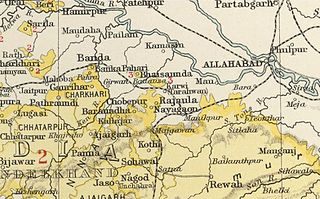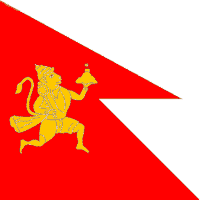| |||||
| Centuries: | |||||
|---|---|---|---|---|---|
| Decades: | |||||
| See also: | List of years in India Timeline of Indian history | ||||
This article details events in the year 1840 in India. Occurrences include the establishment of the Bank of Bombay, and the fall of the Maqpon dynasty.
| |||||
| Centuries: | |||||
|---|---|---|---|---|---|
| Decades: | |||||
| See also: | List of years in India Timeline of Indian history | ||||
This article details events in the year 1840 in India. Occurrences include the establishment of the Bank of Bombay, and the fall of the Maqpon dynasty.

Dewas is a city in the Malwa region of the Indian state of Madhya Pradesh. The municipality was formerly the seat of two 15-Gun Salute state princely states during the British Raj, Dewas Junior state and Dewas Senior state, ruled by the Pawar clan of the Marathas. The city is the administrative capital of Dewas district. Dewas is an industrialised city and houses a government bank note press.

Kunwar Nau Nihal Singh was the third Maharaja of the Sikh Empire. He was the only son of Maharaja Kharak Singh and his consort, Maharani Chand Kaur. He was known as Yuvraj Kunwar Nau Nihal Singh. He was also known as Bhanwar Singh or Bhanwar Sa or Kunwar Sa means Respected Young Prince. Bhawar means Son of Kunwar or Son of Thakur. His reign began with the dethronement of his father Maharaja Kharak Singh and ended with his death at the age of 19 on the day of his father's funeral.

Chand Kaur was fourth ruler of the Sikh Empire, proclaimed as Malika Muqaddisa on 2 December 1840. She was born to Sardar Jaimal Singh of the Kanhaiya Misl. In 1812, she was married to Crown Prince Kharak Singh, son and heir apparent of Maharaja Ranjit Singh and Maharani Datar Kaur. In 1821 she gave birth to their only son Nau Nihal Singh, who became second in line of succession to the throne of Punjab.

The Daly College is a group of institutions consisting of a co-educational private boarding, day school, a private junior school, an undergraduate management school and a postgraduate business school, located in Indore, Madhya Pradesh, India. It was founded by Sir Henry Daly of the British Indian Army during India's colonial British Raj, following an English public school model. The school started in 1870 as the Residency School. It was then renamed as the East Rajkumar College in 1876, and in 1882, it came to be known as The Daly College. It was established by the Resident Governor of the erstwhile Presidency, to educate the children of the royalty, nobility and aristocracy of Central Indian Princely States of the 'Marathas', 'Rajputs', 'Mohameddans' and 'Bundelas'. It is one of the oldest co-educational boarding schools in the world.

Dhar State was a princely state. It was a salute state in the colonial sway of the Central India Agency. Dhar began as one of the states during Maratha dominance in India about 1730. In 1941 it had an area of 1,798 square miles (4,660 km2) and a population of 253,210. Dhar was the capital of the state since 1732 (from the 1728 foundation, the Raja's first seat had been at Multhan in Dhar district. In 1948, it became part of Madhya Bharat.

Sir Pratap Singh Nabha, KCSI was the last ruling Maharaja of Nabha. The state of Nabha was merged into India in 1948. It was annexed to Patiala and the East Punjab States Union, a new political administrative unit that comprised all the states of the Punjab.

Kolhapur State or Kolhapur Kingdom (1710–1949) was a Maratha princely State of India, under the Deccan Division of the Bombay Presidency, and later the Deccan States Agency. It was considered the most important of the Maratha principalities with the others being Baroda State, Gwalior State and Indore State. Its rulers, of the Bhonsle dynasty, were entitled to a 19-gun salute – thus Kolhapur was also known as a 19-gun state. The state flag was a swallow-tailed saffron pennant.

Paldeo, also spelt 'Paldev', was a princely estate (Jagir) in India during the British Raj. It was under the Bundelkhand Agency of the Central India Agency until 1896 when it was transferred to the Baghelkhand Agency. In 1931 it was transferred back to the Bundelkhand Agency. It had an area of 52 square miles. In 1940 its population was 9,820 distributed in 18 villages. Paldeo Estate was merged into the Indian state of Vindhya Pradesh in 1948.

Dewas State was a territory within Central India, which was the seat of two Maratha princely states during the British Raj. After the Maratha conquest of Central India, Dewas was divided into two states - Dewas Junior ruled by Jivaji Rao Puar and Dewas Senior ruled by Tukoji Rao Puar. On 12 December 1818, the 2 Dewas States became British protectorates.

Dewas Junior was established by Jivaji Rao I Puar in 1728 during the Maratha conquest of Central India. It was a 15-gun salute Maratha princely state. On 12 December 1818, it became a British protectorate.
Events in the year 1837 in India.

Hemendra Singh Rao Pawar, is the present titular Maharaja of Dhar State. He is a descendant of the Pawar (Puar) dynasty that ruled Dhar State.

Phulkian Misl was a Sikh misl named after Choudhary Phul Singh.
This article details events occurring in the year 1839 in India. Major events include the reduction of the Khanate of Kalat to a subsidiary ally of the British, and the capture of Aden in Yemen by the East India Company, creating an important stopover for voyages between Europe and India.
This list details events in the year 1838 in India. Major events include the Agra famine of 1837-38, and the founding of the Times of India on 3 November.
Events in the year 1851 in India.

Raja Dhian Singh was the longest serving wazir of the Sikh Empire, during the reign of Maharajah Ranjit Singh, and four of his successors. He held the office for twenty five years, from 1818 up till his death. Dhian Singh was a brother of Raja Gulab Singh of Jammu, who later founded the Dogra dynasty when he became Maharaja of the princely state of Jammu and Kashmir under the British Raj. Another brother Suchet Singh also served the empire. The three brothers were collectively known as the "Dogra brothers" in the Sikh empire, based on their ethnicity.